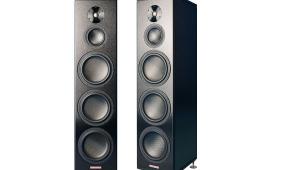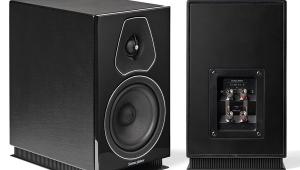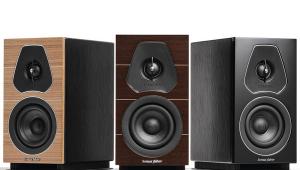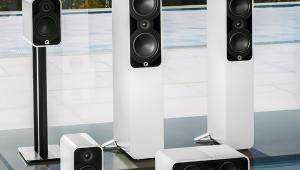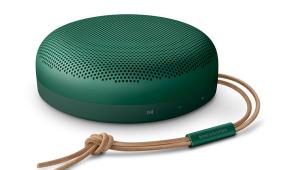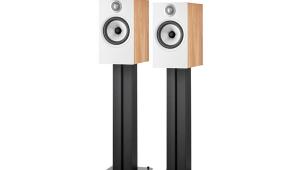Sonus faber Lumina III

 For some companies, the arrival of any new product carries with it a weight of expectation that it will excel in one area above all others. This is challenging enough when that specialism is performance related. And when that reputation is founded on aesthetics, things become harder still. Mention “Sonus faber” to anyone with half an understanding of the audio industry and the perception will be of a piece of art that happens to have drivers in it. Its speakers generally sound very good indeed and they always look wonderful.
For some companies, the arrival of any new product carries with it a weight of expectation that it will excel in one area above all others. This is challenging enough when that specialism is performance related. And when that reputation is founded on aesthetics, things become harder still. Mention “Sonus faber” to anyone with half an understanding of the audio industry and the perception will be of a piece of art that happens to have drivers in it. Its speakers generally sound very good indeed and they always look wonderful.
At the more premium end of the price scale, maintaining this tradition is no problem but when the time comes to make a more affordable speaker, the company has to go the extra mile to create something that doesn’t let the side down even before the business of ensuring it sounds good. The Lumina Series takes on this challenge. The three-strong lineup comprises a standmount, a centre and the floorstanding Lumina III here.
In terms of the driver hardware, the Lumina III is able to make use of drivers employed elsewhere in the Sonus faber range. The tweeter is a 29mm silk unit that appears in the more expensive Sonetto range. Called the Damped Apex Dome, it uses an outer frame to provide local dampening of the dome to avoid anti-phase behaviour. The same installation is used across all three speakers. In the Lumina III, the midrange driver is also borrowed from the Sonetto series. It is a 150mm pulped paper unit with a rather smart logo’d dust cap at its centre.
This joins a pair of 150mm bass drivers that are newly developed for the Lumina III. These are also made from pulped paper, but engineered for low-frequency work and equipped with a conventional dust cap, aided by a port that exits at the bottom of the cabinet to help with placement. A low-frequency cut-off of 40Hz is quoted, albeit with no roll-off figure given. The crossover arrangement is three-way and two sets of speaker terminals are fitted.
In terms of the styling, Sonus faber has managed to convey something of its spirit even if the execution has changed. This is its first design that does without a curved cabinet and, while this is undoubtedly a significant move, I’m impressed at how little it affects the ‘feel’ of the overall speaker. Made of multi-layer wood and available in a choice of three finishes, all complemented by chrome finishers, it manages to feel special in a way that a Sonus faber should.
The use of wood is limited to the front. The rest of the cabinet is finished in an artificial leather wrap that is an intriguing alternative to more mainstream options. Combined with a fixed but fairly compact plinth, the Lumina III matches agreeable proportions with enough of the sense of artistry that we associate with Sonus faber to work as a package, while managing to carry off a (slightly) greater sense of modernity at the same time. It’s a neat balancing act that works well in the flesh.
The more prosaic areas are also dealt with effectively. The build is good and while this doesn’t feel like the most substantial speaker you can buy for £2,000, the level of fit and finish is entirely convincing. Sensitivity is quoted at 89dB with an impedance of 4ohm, meaning it shouldn’t be too challenging to drive, Sonus faber’s suggestion of a minimum of 50W to partner with it feels about right in practise, too.
Sound quality
Connected to a Cambridge Audio Edge A, which comfortably exceeds this figure, the Lumina III makes good on the promise of being fundamentally easy to position. While it does its best work a little way from boundary walls, it is otherwise very consistent in its behaviour almost regardless of how it is sited. I settle on roughly 3m apart, gently toed-in toward the listening position.
The Lumina III manages to balance some of the expected virtues of the Sonus faber house sound with some new tricks. The use of the dedicated midrange driver pays dividends. Operating between 350Hz and 3.5kHz, it gives an impressive emphasis to vocals and critical instruments. Nicolas Michaux’s Amour Colère is reproduced with his soulful vocal turn becoming the centre of attention with the supporting instrumentation arranged as a convincing layer behind. This proceeds upward to the tweeter that balances fine detail retrieval with impressive refinement. The handover between the drivers is encouragingly seamless too. The decision to use a very similar driver for midrange and bass work undoubtedly helps.
There is also a seductive quality to how it presents material that makes it extremely easy to listen to. It isn’t warm, but there is a smoothness and tonal richness that helps it to deliver music in a way that is something you can enjoy for extended periods without fatigue. The bombast of The Comet Is Coming’s Trust In The Lifeforce Of The Deep Mystery is fuller and less jarring than it can be on other speakers, but the clever part of this balance is that the fury and frenetic energy of the performance is retained while it does so.
However, not everything is quite so accomplished. For a speaker standing nearly a metre tall and possessed of a pair of bass drivers, the Lumina III’s low end never feels hugely potent. As with all aspects of speaker design and voicing, it feels like Sonus faber has favoured the integration between drivers over outright punch. If you absolutely must have the punch-in-your-sternum-style impact that some designs can offer, this probably isn’t the speaker for you. This also has a slight but perceptible effect on the sense of scale that is delivered.
There is a twist to this, though, that is slightly unexpected. Whatever trade-offs have been made in terms of bass weight result in good speed and dynamics. The idea that Sonus faber speakers are languid and optimised purely for gentle activities has always been a little overblown, but the Lumina III has a speed and attack to its presentation that is bit of a surprise. The way it deals with Mark Lanegan’s crunching The Gravedigger’s Song is hugely and unapologetically entertaining. There’s just enough civility to ensure it doesn’t overstay its welcome, but it is far more visceral than you might reasonably expect.
No less impressive is that the forgiving edge doesn’t rob the Lumina III of the ability to shine with better recordings. Poppy Ackroyd’s stunning Resolve – as effortless a blurring of the margins of modern classic and electronica as I’ve yet to hear – is masterfully reproduced. The fascinating details of Ackroyd’s work (when she ‘plays’ a piano, she doesn’t merely use the keys) are stitched into the wider performance in a way that illuminates its presence without it becoming a distraction. The presentation fizzles with an energy that compels you to keep listening.
Conclusion
This then, is a speaker that gives some nods to expectations, but in both looks and performance brings something new to the table too. The company has managed to bring enough of its aesthetic and performance to the Lumina III that it is unquestionably a Sonus faber product, but this is combined with some new thinking in both the looks and the sound to hopefully win over some fresh converts. ES
DETAILS
Product: Sonus faber Lumina III
Type: Three-way floorstanding loudspeaker
FEATURES
● 29mm silk dome tweeter
● 150mm pulped paper midrange driver
● 2x 150mm pulped paper bass drivers
● Quoted sensitivity: 89dB/1W/1m (4ohm)
 |
Inside this month's issue:
Q Acoustics 3020c standmount loudspeakers, Perlisten R10s active subwoofer, Quad 33 and 303 pre/power amps, Acoustic Solid Vintage Full Exclusive turntable, newcomer Fell Audio Fell Amp and Fell Disc and lots, lots more...
|






